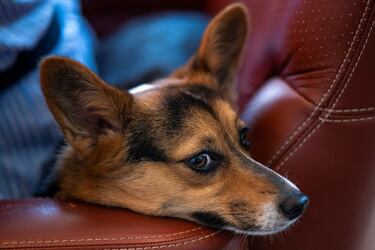The huge mistake you make when you come home to your dog that professionals advise against
We all love walking through the door and enthusiastically greeting our dog, but it might not be the best thing for them.


One of the best moments of the day for dog owners is coming home after a long day at work. You know your best friend will be waiting for you and will give you a big welcome as soon as you walk through the door. And of course, you’ll return the favor because you’ve missed them too. This is a ritual in almost every dog-owning household, but according to some experts, it might not be the best thing for your furry friend.
According to Steve Del Savio, owner of Pack Leader Dogs, this is exactly what you shouldn’t do. In a video posted on his TikTok account, Del Savio explains that it’s not a good idea to greet and shower your pet with affection as soon as you walk in the door.
"My son always texts to say he's on his way home. So I open the door, letting his 17 year old cat, and 16 year old doggo know that he's on his way. This is them waiting for him. Though it was adorable, and wanted to share." ❤️ pic.twitter.com/ACSPxdnxKH
— The Dalbo Dog (@Dalbodog) September 14, 2024
How to greet your dog
The technique explained by Pack Leader Dogs is based on no touch, no talk, no eye contact. It may seem a bit extreme, but the video explains the reasoning behind it. And honestly, although it may seem nearly impossible, not focusing all your attention on your dog when you get home might actually make a lot of sense.
@packleaderdogs Whenever I do a post about this, I get people who make comments like, "You must be fun at parties'" or "Do you even love dogs?" The way I see it, I love my dogs enough to sacrifice my pleasure of petting them highly aroused at the front door, which is more for fulfilling my emotions than theirs. I'm always thinking about whats best for them before whats best for me. I realize that practicing no touch, no talk, and no eye contact with your dog when you return home isn't the most pleasurable or fun experience for YOU. It would be way for fun and to get all excited, look right at them, start petting them to get them even more aroused, and say, "Hi guyssssss!" The problem with that is that I'd be creating an association at the door that when humans enter, the dogs are expected to practice excitement/arousal. As that excitement/arousal increases, it can turn into whining, jumping, and barking when we arrive home. Then, when a friend, family member, delivery person, etc. come to your front door, your dog will likely get very aroused/excited. With this association, some dogs will just be a handful to deal with at the front door. Jumping on guests, barking, whining, invading space, running crazy, etc. But with some dogs, that arousal/excitement can be paired with fear when it's not a person they know which can cause them to panic, run away, growl, bark, or even try to bite. My suggestion is when you come home not to make it such a big event. As you can see, my dogs are still happy to see me but aren't going crazy. By not touching, talking, or giving direct eye contac right away, it allows the dogs meet us the way they naturally do with rheir own species, by using their nose to see where weve been, how we feel and who weve been around. After that event is over, I'll walk in, put my things down, and maybe take care of a few things while the dogs relax. Once they are relaxed, I'll go give affection, take them out to play, go for a walk, etc. The key is making sure the event of "human entering door" is complete and finishes with calmness before doing anything else. Does practicing no touch, no talk, no eye contact at the front door make sense to you?
♬ original sound - Pack Leader Dogs
According to Del Savio, our dogs need to learn that there’s no need to throw a party every time someone walks through the door. If we teach them that people coming home are calm and collected, it can help the dog manage their energy and expectations.
In theory, this sounds easy, but putting it into practice could be one of the hardest things to do when training your pet. The level of self-control required to come home after a long day and not immediately greet and pet your dog is practically superhuman.
READ ALSO: What are the dog breeds considered aggressive in the USA?
Because of this, the comments on the post aren’t too enthusiastic. “I can’t not go crazy when I see my dog,” says one TikTok user. “When I come home is the best part of the day for my dog. I would not deprive him of that” comments another.
Some users have found the Pack Leader Dogs video helpful. “I accidentally started doing this. One day I realized it was much easier to walk through the door with my two 85lb goldens. Now I have a puppy golden so I’m glad I realized this,” says one commenter, who is happy with the results of this dog training technique.

What do other experts say?
Although Del Savio’s advice seems to make sense, other experts argue that greeting your dog when you come home is actually beneficial for them. A study by Psychology Today states, “At the sight of the familiar person returning, the dogs became more active, with tails wagging. The sight of that familiar person was obviously a positive event (...). When the familiar individual greeted the dog using both their voice and touch, the increase in oxytocin went up to much higher levels than it did when the greeting involved just voice alone.”
So what should we do? Some experts argue that it’s good to show affection when you get home, while others say it’s better not to excite them. There are opinions for every taste. One thing is clear: if we opt for the no touch, no talk, no eye contact approach, we’ll have to fight all our instincts. Whatever it takes to make our dogs happier.
Related stories
READ ALSO: ‘Dognition’ and what you need to know about your pup’s communication
*This article was written in Spanish and translated with the help of AI.
Complete your personal details to comment